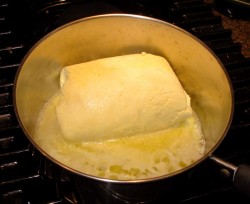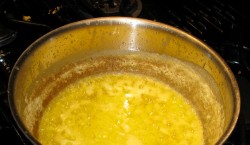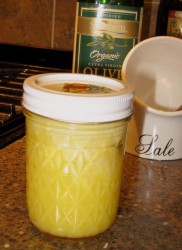Golly Gee, I Mean, Ghee
Usli ghee, or as it is more commonly known, ghee, is the Indian style of clarified butter. It is a rich, delicious, nutty-flavored pure butterfat product which not only has a higher smoking point, so it makes a good medium for frying, it adds an amazing depth of flavor to Indian foods. Many Indian vegetarians use ghee a great deal as a cooking oil, but also as a flavoring agent. In Ayeuvedic medicine, ghee is considered quite healthful and in Indian culture, it is considered among the purest and most sacred of foods.
You can buy ghee at the Indian market, but it is not hard to make at home and the end product has a fresher, more nutty flavor than the commercial product.
Making it just takes a bit of time and attention.
You start with a pound of butter–unsalted cultured butter is best for an authentic flavor. However, if you are unused to the flavor of cultured butter, which is made by allowing the cream to sit and be inoculated with a bacteria similar to the one which makes yogurt, then, I would say that you should make your first batch of ghee with sweet cream butter. The butter pictured here is from our new local creamery, and judging by the slightly cheesy aroma and tangy flavor, it is cultured butter.
All you have to do is put it in a pot, and melt it over medium low heat.
Don’t stir it. Once it is melted, turn the heat down to low, and watch, smell and listen.
What are you watching for?
You are watching the some of the milk solids float to the top in the form of foam–which you skim off and discard, and sink to the bottom, where they form a layer of ook on the bottom of your pot.
The goal is for that layer of ook to brown without burning while the butter bubbles along, boiling away the water that is inherent in butter.
Your job is to keep turning the heat down so that your milk solids can brown slightly–which gives the finished ghee a delicious, nutty aroma and flavor, and to listen for the burbling sound of the water cooking off to stop. In the second photo, you can see how the milk solids have begun to brown, not burn. Burned milk solids will fill your house and your ghee with a bitter, acrid aroma, which is, to put it nicely, not desirable either in a comestible or a domicile.
Once the bubbling stops, and the milk solids are browned, the ghee is finished.
All you have to do is pour it through a fine mesh strainer or several layers of cheesecloth to catch any wayward milk solid bits which are either left floating on the surface of the ghee or which might detach themselves from the bottom of the pot and try and sneak into your container.
What is left is pure butterfat which will solidify at seventy degrees–or room temperature. I seal mine up in a canning jar and keep it at room temperature in a cabinet next to the stove. It doesn’t need to be refrigerated and if you do–it is harder to remove a specific amount from the jar. Chipping away at it with a table knife or spoon is tedious and results in bits of it flying from the jar and landing on your face, your hair, the countertop and possibly even your cat. And while your cat might not mind–especially since he or she would get a nice taste of ghee while they cleaned themselves up–you might mind your hard work going to waste. (Though if you get some on your face, rub it in. It makes a nice moisturizer. Though, if you fall asleep with it there, you may awaken to a cat’s raspy tongue licking it off.)
It lasts for months if you keep it tightly sealed and away from light and extreme heat. I would say three to six months, really.
All fats will go rancid if not handled properly–even vegetable fats. (Nuts are a big culprit for going rancid–ick!) If there is any doubt about your ghee–if it has an off scent, then taste it. If there is any bitterness to it, or an unpleasant–dark, dank smell and flavor–it has gone rancid. Throw it out.
You can keep it in the fridge to keep it longer, but, you have to remember to take it out long before you use it to soften it up so you can get it from the jar. Yes, you can microwave it to soften it, but repeated heating and cooling will make it not last as long, so you lose the benefit of keeping it in the fridge.
Now that you know how to make ghee, I can tell you very easily how to make clarified butter in the French fashion. Do the same stuff you do for ghee, except don’t let your milk solids brown on the bottom. The French don’t seem to care for that nutty flavor that I think makes ghee so special and delicious.
What do you do with ghee once you have it?
I love to use it in making tarkas to enrich the flavor of dals, but you can use it in any Indian recipe you like.
The possibilities are endless.
10 Comments
RSS feed for comments on this post.
Sorry, the comment form is closed at this time.
Powered by WordPress. Graphics by Zak Kramer.
Design update by Daniel Trout.
Entries and comments feeds.






How long does ghee last? Will it eventually become rancid?
Comment by valereee — December 18, 2007 #
Marvelous! Ghee is one of those things I always mean to get to and somehow never do. Now I know where to come for excellent instructions. Thanks!
Comment by Ann — December 18, 2007 #
hi barbara,
that’s a great post about ghee (neyyu / nei – in malayalam.) we make ghee from scrap. i make my own curd, by adding boiled, cooled milk (even the milk gone bad a little can be used), to a small quantity of curd or buttermilk, which is left outside the refrigerator for some hours. keep adding the leftover milk to this. if the curd is not all used up, i separate the butter from it. at home, my mother still uses the traditional ‘kadakol,’ a wooden utensil used to churn the curd, but i use the mixer. a couple of seconds whirring, then leave it alone for some time. butter will collect on top. scoop up with a spoon, put it into boiled, cooled water in a bowl and put in the refrigerator. once it solidifies, pour out the water and collect the solid butter. this is the butter that we were familiar from childhood. the slightly sour taste of this fresh butter is just heavenly. sometimes, mothers would mix some of this fresh butter with hot rice for children, considered a special treat. but, this butter would go rancid soon. even in the refigerator it wont last more than one or two weeks. so, the sooner its made into ghee the better.
but i haven’t tried melting the butter, due to the bubbling. its left to either my hubby, the maid, or whoever willing !the most common use for ghee here is to add to rice, as the first course of a festive meal. when i was growing up, a little ghee mixed with hot rice and pappadams with some vegetable upperi (stir fry) was our daily breakfast before going to school. ghee is usually not eaten at night, as its too heavy and never with cold rice.
mix some ghee with plain boiled lentils tuvar dal), and eat with rice. it makes the perfect, balanced, tasty meal. in most kerala homes, it is considered the normal lunch for small kids.
mother would sprinkle some cooked rice into the pan in which ghee was made, mixing it with whatever remains in it. that was special treat of the day.
sour curries, or curries like sambar with pungent gravies are not usually eaten with ghee. even now, the first course of a traditional feast (‘sadya’) is ‘neyyum parippum,’ (tuvar dal and ghee).
enough of ghee ? but just so wonderful to see some one in distant america making ghee !
Comment by renu — December 18, 2007 #
Valeree–I thought I had mentioned that in the post. Of course, when writing late at night, I think I have mentioned lots of things. So, I went back and edited the information in, because it is important. About six months. I usually use mine up long before that, but I have read six months on the labels of commercial ghee.
Ann–it is quite easy. Do give it a try!
Renu–it is always wonderful to hear from you. I love hearing about the Kerala traditions of food from you–you are so full of knowledge about them.
The slightly sour taste of butter–my own grandfather loved it. His parents were German, and they cultured their butter, so in order to get a similar flavor, since he didn’t churn his own butter, he would leave regular butter out at room temperature, unwrapped, but in a breadbox or closed cabinet, and it would develop a wonderful nutty flavor. It was great–and there was always soft butter in the house.
His kids hated that flavor–they thought the butter had gone rancid but I always loved it.
Now, I do the same thing, or buy cultured butter or, I make ghee out of cultured butter, to get the same flavor.
Comment by Barbara — December 18, 2007 #
I got my first pot of ghee because it’s essential for my mom’s morog pulao recipe but it’s handy for other things as well. We did consider making our own but weren’t quite sure, so your post is really helpful!
Comment by Scheherazade — December 18, 2007 #
I used to buy ghee, but now I make it regularly, and you are right – it is super easy. I keep mine in the pantry in a small metal jar, and scoop it out as needed. It lasts months and months, but as I only make mine in small increments at a time it never really gets tested beyond a month or two. I learned quickly not to refrigerate it as you end up having to “shave” it out of the jar rather than scoop it.
Oh – and it makes the house smell SO good while making it. The only tricky thing at all is not to walk away and take a shower or something while it’s on the stove, as it can go from golden to burnt fairly quickly once it gets “done” and to the right stage. A bit toasty is fine, and you can over-cook it for a bit with no huge ill effects though. I have made it from golden to caramel colored, depending on when I notice it being done. I always wait until the boiling/bubbling stops, indicating water has left it, and it settles down to a nice low simmer, with just a few tiny bubbles, and no “spitting” to indicate it is done.
I would encourage everyone to make it. The first time I tried, I thought – “that’s it? that’s all there is to it?” It’s easy, and you know exactly what is in it. I make mine with organic butter. You don’t know how old the stuff in the stores is. And you don’t know how thoroughly they processed it to get all the water out of it – more water means a cheaper, higher margin product but also one that doesn’t last as long. And you don’t really know if it is 100% butter fat. So much better to make your own.
Comment by Diane — December 19, 2007 #
dear barbara,
thank you for your appreciation. its wonderful to hear about your grandfather. i had always been wondering from at which point did the western civilisation, especially the american, started moving so much away from the natural state of things. recently, i happened to come across an interesting website,(you can find the link here – http://waltonfeed.com/old/lifes-rec/index.html), which describes life in a farm house in the early part of 20th century.
industrialisation and mechanisation is creeping into the everyday life of india, and kerala, as well. these days, people prefer to buy their rice and wheat flour. batter for idly / dosa is now available in plastic packets, over the counter. and masala powders abound, in all varieties. people have started buying packaged skinned small onions, canned coconut milk and packaged ground mixture of fried coconut and chillies for making the spicy theeyal. even ready-to-serve curry packets of all sorts are now lining up the supermarket rows.
but, thankfully, there are a lot of people who prefer to do things from the scratch. like we making curd and ghee. we don’t use sambar powder. my husband, a die-hard enthusiast of traditional cooking, never believes in powders ! corriander powder is kept for emergencies only. usually, a spoonful of corriander is roasted for some seconds and powdered in the mixer. we do buy the batter. but that is because we don’t plan early enough for making idlies ! and at least, these batter packets are locally made, often packed in front of you from the grinders.
i wonder whether you’ve visited kerala ever. if not, i am inviting you. by the time kat grows up a little bit and gets ready for globe-trotting, get ready to visit kerala. we live in kochi. you can visit the most untouristy places, i promise ! we have a lot of american / european friends, some of whom have settled down here !
love,
renu.
Comment by renu — December 20, 2007 #
Renu: I was in Kerala three years ago, and LOVED it. It truly is “God’s Own Country” as the slogan goes. I liked the people and the food. I was there on a cultural and cooking trip, so got to learn some true Kerala cooking.
I am an American, but like you I prefer to make everything from scratch. I make idli batter from scratch, and always grind my spices. Of course, here in the US the coconuts (from Mexico) are pretty anemic, so I definitely buy canned coconut milk. Some of the Thai brand here are really excellent.
Thank you for all your thoughtful posts – I always enjoy reading them.
Comment by Diane — December 20, 2007 #
I’ve had a vegetarian cookbook for ages that lists ghee as an ingredient in several recipes, all of which I ignored as I was clueless to what it was and assumed it would be difficult to find. How easy! I have loads of butter left over from holiday cooking, I’m going to have to go home and make some so I can finally try out some of those recipes!
Funnily enough I made cookies from a recipe last week that called for browned butter which is basically the same thing. They were delicious.
Comment by Tee — December 26, 2007 #
Hello, I read someone asking about the duration of Ghee…
I found it writen in an Ayur Vedic
book I have, that ghee become very toxic (but still used as medicine)
“Ghee that is aged ten years or more becomes a powerful toxin that is used medicinaly…useful in obesity, epilepsy, vertigo, headaches and eye and ear disorders…mix with water and given in tiny drops…it is so powerful that it can revive a man from a coma”
from the book:
Lessons From The Ayurveda by Navayauvana dasa Adhikari
Well, have a good journey
Janardan Das from Montreal
Comment by Janardan Das — January 4, 2008 #